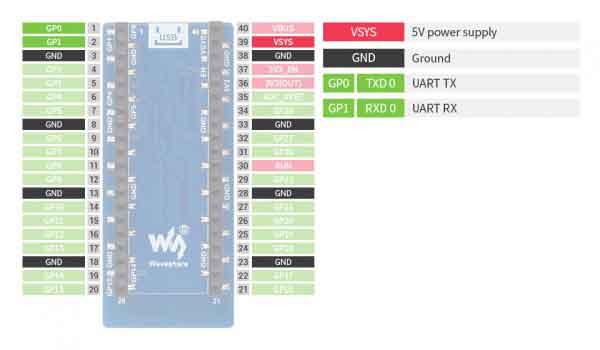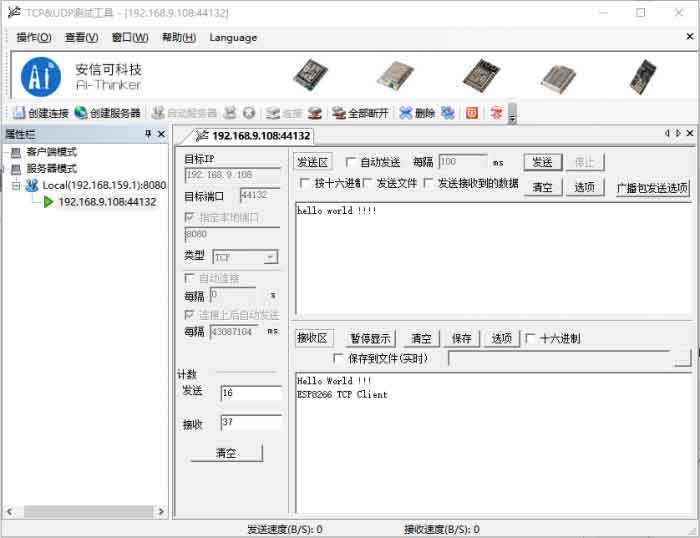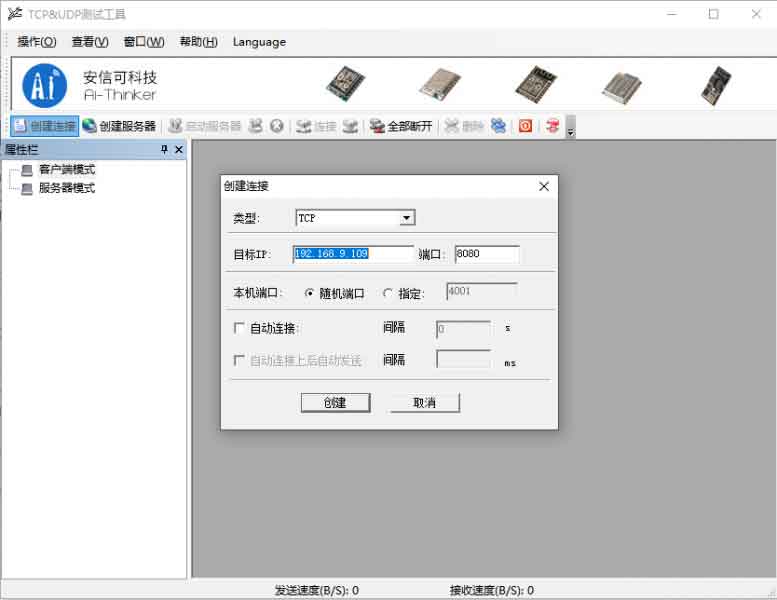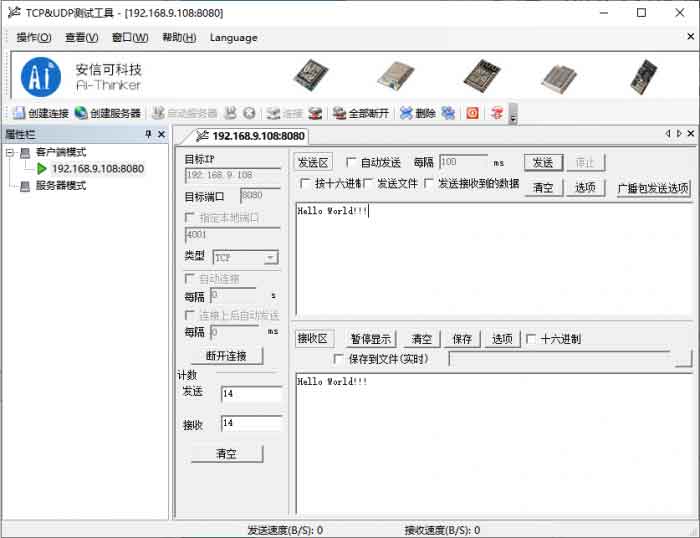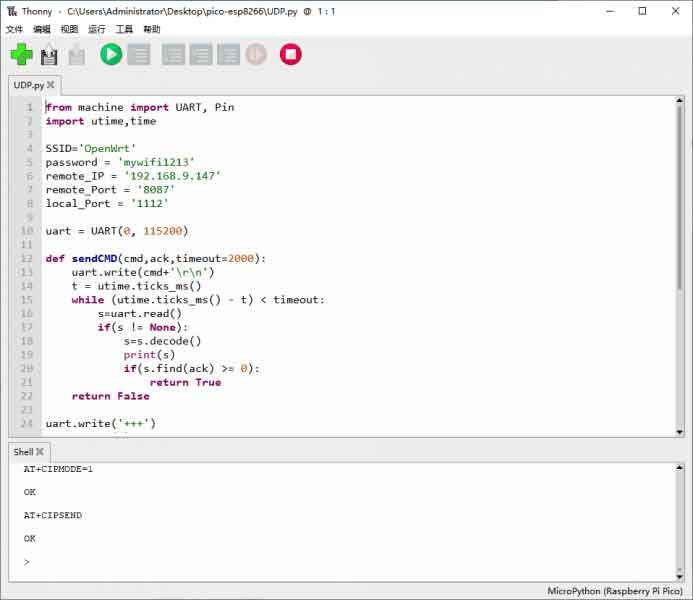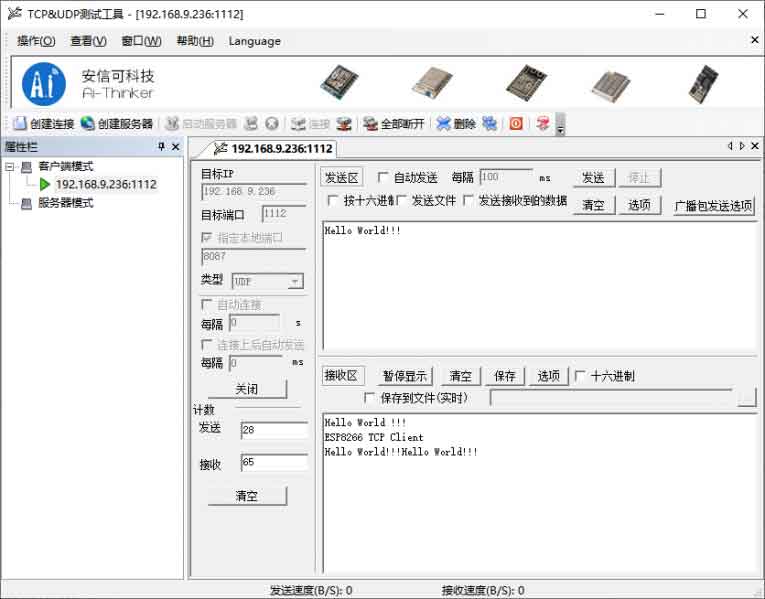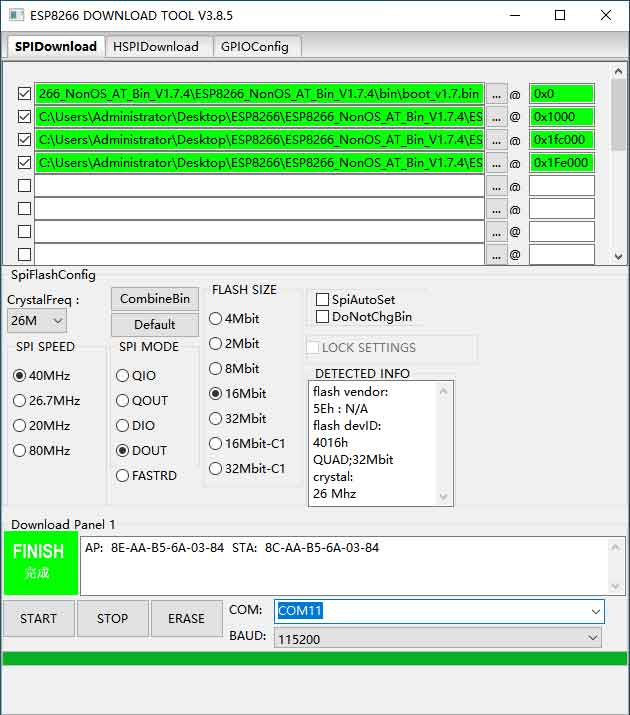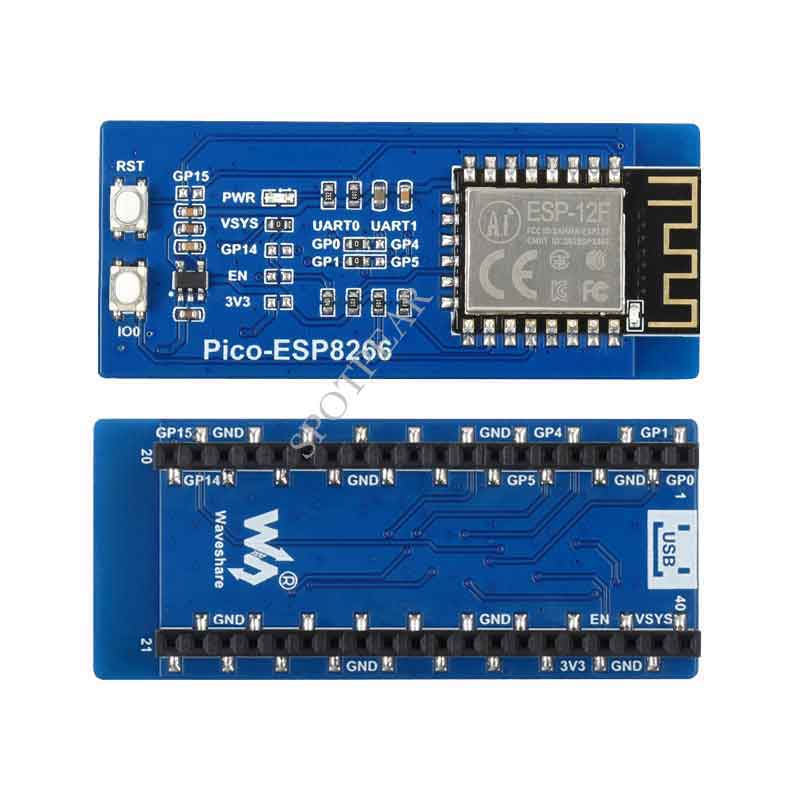- sales/support
Google Chat: zj734465502@gmail.com
- sales
+86-0755-88291180
- sales01
sales@spotpear.com
- sales02
dragon_manager@163.com
- support
tech-support@spotpear.com
- CEO-Complaints
zhoujie@spotpear.com
- sales/support
WhatsApp:13246739196
Raspberry Pi Pico ESP8266 User Guide
Overview
The Pico-ESP8266 is a WiFi expansion module designed for Raspberry Pi Pico, which can be controlled via UART AT command, and supports TCP/UDP communication protocol. It is an easy solution to enable WiFi feature for Raspberry Pi Pico, suitable for sorts of IoT communication projects.
Features
- Standard Raspberry Pi Pico header supports Raspberry Pi Pico series
- UART communication, controlled via AT command, helps you get started quickly
- Supports STA, AP, and STA+AP three WiFi operating modes, embedded LWIP protocol stack, supports TCP/UDP communication
- Based on ESP8266 module, four-layers process, enhanced impedance matching, stronger signal, more stable connection
- 2x functional buttons, convenient for the user to update AT firmware through Raspberry Pi Pico
Specification
- Communication interface: UART
- UART baud rate: 115200 bps
- WIFI standard: IEEE 802.11b/g/n
- Frequency range: 2400 ~ 2483.5MHz
- WIFI operating mode: WiFi STA, WiFi AP, WiFi STA+AP
- Antenna: PCB antenna
- Operating voltage: 3.3V
- Operating temperature: -40°C ~ 85°C
- Dimensions 58 x 25mm
Pinout
Quick start
Hardware connection
- Press and hold the BOOTSEL button of Pico, the pico will be recognized as a movable disk, copy the dev_cdc_ports.uf2 file from demo codes to the Pico, the Pico will automatically restart and work as the USB to serial adapter.文件复制到U盘中下载程序。Pico将变成一个USB转串口设备。
- Connect the Pico_EPS8266 board to Pico, then connect the Pico to PC by USB cable.
- Open an SSCOM software, choose the correct COM port, and set the baud rate to 115200.
- Test the module by AT command
AT commands
- 1. AT
AT Response: AT OK
- 2. AT+RST Restart device
AT+RST Response: AT+RST OK
- 3. AT+GMR Check version
AT+GMR Response:: AT+GMR AT version:1.2.0.0(Jul 1 2016 20:04:45) SDK version:1.5.4.1(39cb9a32) Ai-Thinker Technology Co. Ltd. v1.5.4.1-a Nov 30 2017 15:54:29 OK
TCP Client
- 1. Configure WiFi mode
AT+CWMODE=3 //softAP+station mode Response: : OK
- 2. Connect to router
AT+CWJAP="SSID","password" //SSID and password of router Response: : AT+CWJAP="SSID","password" OK
- If it success to connect the WIFI, it will response and get IP address
WIFI CONNECTED WIFI GOT IP
- 3. Check the IP address of ESP8266
AT+CIFSR Response: : +CIFSR:APIP,"192.168.4.1" +CIFSR:APMAC,"1a:fe:34:a5:8d:c6" +CIFSR:STAIP,"192.168.3.133" +CIFSR:STAMAC,"18:fe:34:a5:8d:c6" OK
- 4. PC and ESP8266 are connected to the same router, use the network debugging tool in the PC end, establish a TCP server.
- For example, build a server in PC with IP address 192.168.3.116 and port is 8080.
- 5. ESP8266 work as a TCP client, and connect to the server
AT+CIPSTART="TCP","192.168.3.116",8080 //protocol, server IP and port Response : CONNECT OK
- 6. ESP8266 device ends data of a specified length to the server
AT+CIPSEND=4 //set date length which will be sent, such as 4 bytes >test //enter the data, no CR Response : Recv 4 bytes SEND OK
- 7. The data is printed if ESP8266 receive data from server.
+IPD,n:xxxxxxxxxx //received n bytes, data=xxxxxxxxxxx
- 8. Enable the transparent transmission mode, data can be directly transmitted
AT+CIPMODE=1 Response : OK
- 9. If the transparent transmission mode is enabled, data can be directly transmitted
AT+CIPSEND > //From now on, data received from UART will be transmitted to the server automatically.
- 10. Exit sending data:
If +++ is detected in a single packet of data during transparent transmission, the system stops transparent transmission.
- - If you use the keyboard to type +++, it may take too long and is not considered as three consecutive + s. You are advised to use a serial port tool to send +++ at a time and do not carry invisible characters such as Spaces or newlines.
- - Please send the next AT command AT least one second later
- 11. Exit the transparent transmission mode
AT+CIPMODE=0 Response : OK
- 12.Disconnect TCP
AT+CIPCLOSE Response : CLOSED
OK
TCP Server
- 1. Configure WiFi mode
AT+CWMODE=3 //softAP+station mode Response : OK
- 2. Connect to router
AT+CWJAP="SSID","password" //SSID and password of router Response : OK
- 3. Check IP address of ESP8266 device
AT+CIFSR Response : +CIFSR:APIP,"192.168.4.1" +CIFSR:APMAC,"1a:fe:34:a5:8d:c6" +CIFSR:STAIP,"192.168.3.133" +CIFSR:STAMAC,"18:fe:34:a5:8d:c6" OK
- 4. Enable multiple connection
AT+CIPMUX=1 Response : OK
Note: If "IPMODE must be 0" appears, it is necessary to disconnect ESP8266 and then enter the command. If not, press the button or power off to restart the module and then operate again.
- 5. Build TCP server
AT+CIPSERVER=1 // default port = 333 Response : OK
- 6. The PC and THE ESP8266 are connected to the same router. Use the network debugging tool on the PC to establish a TCP client and connect to the TCP server of the ESP8266
- 7. Send data
//ID number of connection is defaulted to be 0. AT+CIPSEND=0,4 //send 4 bytes to connection NO.0 >test //enter the data, no CR Response : Recv 4 bytes SEND OK
- 8. When the ESP8266 device receives data from the server, the following message is displayed:
+IPD,0,n:xxxxxxxxxx //received n bytes, data=xxxxxxxxxxx
- 9.Disconnect TCP
AT+CIPCLOSE Response : CLOSED OK
UDP
UDP transmission does not distinguish between server and client and is established by the AT+CIPSTART command.
- 1. Configure WiFi mode
AT+CWMODE=3 //softAP+station mode Response : OK
- 2. Connect to router
AT+CWJAP="SSID","password" //SSID and password of router Response : AT+CWJAP="SSID","password" OK
- If the connection is normal, it may prompt you to connect to WIFI and obtain the IP address.
WIFI CONNECTED WIFI GOT IP
- 3. Example Query the IP address of the ESP8266
AT+CIFSR Response : +CIFSR:APIP,"192.168.4.1" +CIFSR:APMAC,"1a:fe:34:a5:8d:c6" +CIFSR:STAIP,"192.168.3.133" +CIFSR:STAMAC,"18:fe:34:a5:8d:c6" OK
- 4. The PC and the ESP8266 are connected to the same router. Use the network debugging tool on the PC to set up a TCP server.
- For example, build a server in PC with IP 192.168.3.116 and the port is set as 8080
- 5. Enable multiple connection
AT+CIPMUX=1 Response : OK
Note: If "IPMODE must be 0" appears, it is necessary to disconnect ESP8266 and then enter the command. If not, press the button or power off to restart the module and then operate again.
- 6. Create a UDP transport. For example, to assign a joined number of 4, the instruction is as follows:
AT+CIPSTART=4,"UDP","192.168.101.110",8080,1112,0 Response : 4, CONNECT OK
Note:
About the command:
- "192.168.101.110", 8080 is the remote IP and port transmitted, that is the UDP port build in step 4;
- 1112 is the local UDP port of ESP8266, it is configurable, or a random port
- 0 Indicates that after the current UDP transmission is established, the UDP remote device will not be changed by other devices. Even if other devices send data to ESP8266 UDP port 1112 through UDP protocol, the remote end of THE UDP transmission no. 4 of ESP8266 will not be replaced. If the command "AT+CIPSEND=4, X" is used to send data, the current PC will still receive the data.
- "192.168.101.110", 8080 is the remote IP and port transmitted, that is the UDP port build in step 4;
- 7. Send data
AT+CIPSEND=4,7 //Send 7 bytes to transmission NO.4 >UDPtest // enter the data, no CR Response : Recv 7 bytes SEND OK
Note:
- • When sending data, if the number of bytes entered exceeds the set length(n):
- - The system prompts BUSY, sends the first N bytes of data, and responds SEND OK when the sending is complete.
- - The data that exceeds the length is considered invalid and is not accepted.
- - The system prompts BUSY, sends the first N bytes of data, and responds SEND OK when the sending is complete.
- 8. Receive data. When the ESP8266 device receives data from the server, the following information is displayed:
+IPD,4,n:xxxxxxxxxx //received n bytes, data=xxxxxxxxxxx
- 9. If the transparent transmission mode is enabled, data can be directly transmitted.
AT+CIPMODE=1 Response : OK
- 10. The ESP8266 device transmits data to the server through transmission
AT+CIPSEND > //From now on, data received from UART will be transmitted to server automatically.
- 11. Exit sending data:
If +++ is detected in a single packet of data during transparent transmission, the system stops transparent transmission.
- - If you use the keyboard to type +++, it may take too long and is not considered as three consecutive + s. You are advised to use a serial port tool to send +++ at a time and do not carry invisible characters such as Spaces or newlines.
- - After that, send the next AT command AT least one second later.
- 12. Exit the transparent transmission mode
AT+CIPMODE=0 Response : OK
- 13. Disconnect UDP transmission
AT+CIPCLOSE=4 Response : 4, CLOSED OK
MicroPython Example
Before Pico can run MicroPython programs, you need to download the MicroPython firmware, install the Thonny IDE, and configure the motherboard environment with the Rasberry Pi option.
TCP Client
- 打Open the TCP&UDP test tool, create the server, and start the server.
- Open tcp_client.py in Thonny IDE and change the SSID and password to the actual WiFi account and password. Change the values of ServerIP and Port in the program to the IP and Port of the actual TCP server.
- Click run program. After running, the program will connect to WiFi and send data to the server. The information sent by the server is displayed in the shell.
TCP Server
- Open tcp_server.py program in Thonny IDE and change SSID and password values to the actual WiFi account password.
- Click to run the program. After the program runs, it will connect to WiFi and start the server. The SHELL displays the STAIP address of ESP8266.
- Open the TCP&UDP test tool, create a connection, set the type to TCP, target IP to the STAIP address displayed in the shell, port 8080.
- Click the "connect" button to connect to the server. After normal connection, the icon changes from blue dot to green triangle.
UDP
- Open the TCP&UDP test tool, create a connection, select UDP as the type, the destination IP address is the STAIP address displayed in the shell after running the program, the port is 1112, and the local port is 8087. Select Create and Connect.
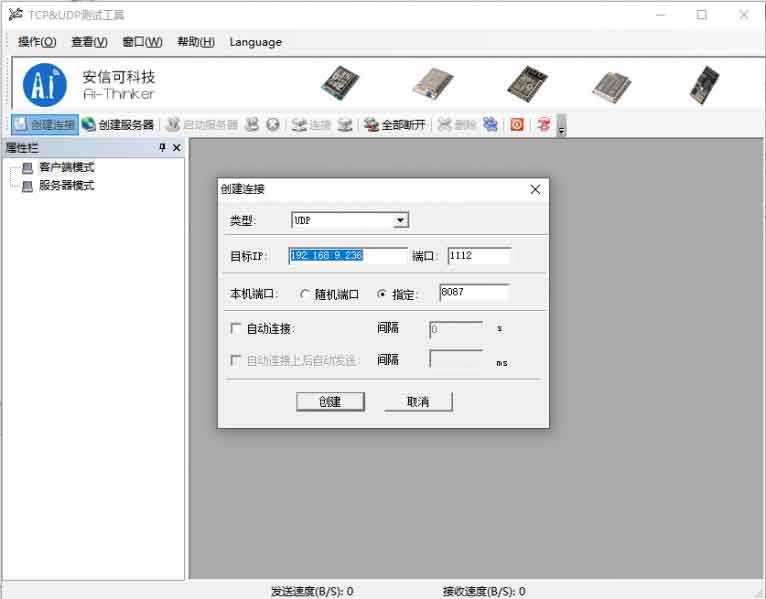
- Open tcp_server.py program in Thonny IDE and change SSID and password to the actual WiFi account and password. Set remote_IP to the actual IP address of the computer
- After the program runs, it will connect to WiFi and send data to UDP on the computer side. Enter a string in the send area and send it. ESP8266 receives the message and sends it back for display in the receiving area. The shell port will also display the received information.
C/C++ codes
- C/C++ is compiled in Raspberry PI. This step can be skipped if the Pico compilation environment has been configured for Raspberry PI. If the Pico compilation environment has not been configured, perform the following operations.
wget https://raw.githubusercontent.com/raspberrypi/pico-setup/master/pico_setup.sh chmod +x pico_setup.sh ./pico_setup.sh
- Download the demo codes
cd ~ wget https://www.waveshare.com/w/upload/4/41/Pico-ESP8266.zip unzip Pico-ESP8266.zip cp -r Pico-ESP8266/c/pico-esp8266 pico
- Before compiling the program, you need to modify the program and change the values of SSID and password to the actual WiFi account password. Change the values of ServerIP and Port in the program to the IP and Port of the actual TCP server.
- compiler
cd pico/pico-esp8266/build cmake .. make
Download AT Firmware
- Hold the Pico's BOOTSEL button and power on. The computer will recognize a USB flash drive and copy the dev_CDC_ports.uf2 file from the sample program to the flash drive to download the program. The Pico will become a USB-to-serial device.
- Run the flash_download_tool software.
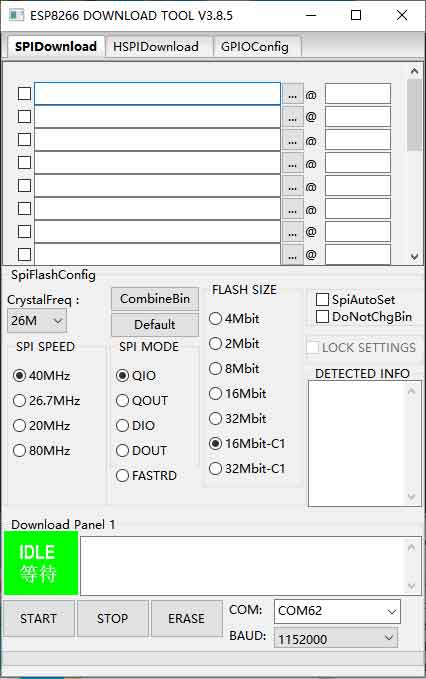
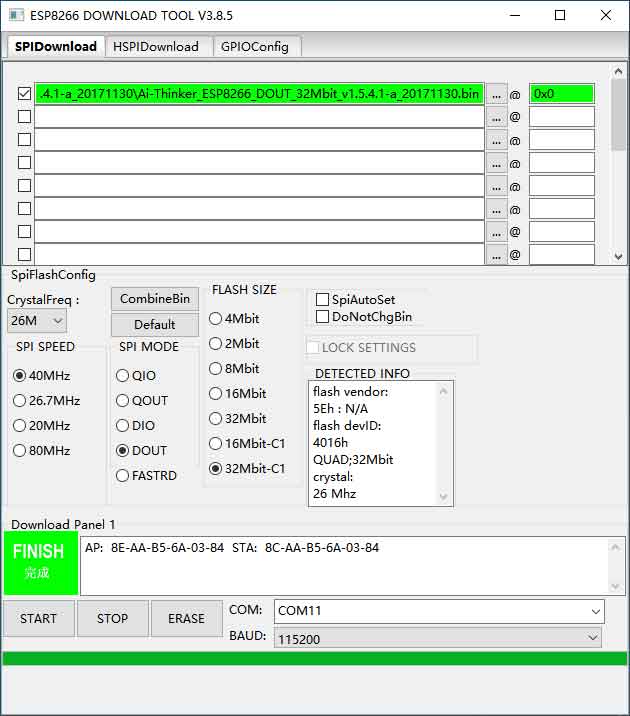
- Hold the IO0 button of the PICo-ESP8266 and then press the RESET button to enter download mode. Select the corresponding serial port and set the baud rate to 115200. Click START and wait for the download to complete.
- To set the AT firmware for nonOS_AT_BIN_V1.7.4, follow the following figure.




